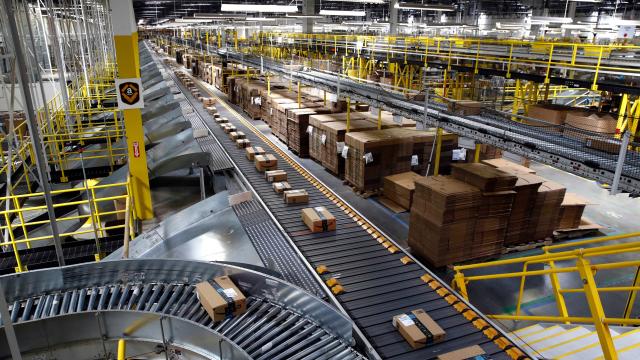Amazon recently came under fire when the Verge revealed it used a system that automatically determines the productivity levels of its warehouse workforce, and terminates laggards if they’re too slow to move packages. It was yet another sign that automation was taking over at the retail giant, and a particularly ominous one at that.
In a subsequent press tour of its Baltimore fulfilment centre, ostensibly intended to parry against this latest volley of charges of extreme and robot-like working conditions, Scott Anderson, director of Amazon Robotics Fulfilment, took pains to highlight the human element still necessary at the company’s capacious warehouses.
“There is a fallacy in the initial understanding of ‘Are we going to be a lights-out fulfilment network in the next few years?’” Anderson said, according to Reuters. “In the current form, the technology is very limited. The technology is very far from the fully automated workstation that we would need.”
He said that technology wouldn’t be there for about another 10 years—which, from his point of view in the technology industry, is a rather long time. To the 100,000 plus people who work at Amazon’s fulfilment centres, and to the local economies and social systems that will need to cope with such a large influx of automated-out-of-work employees, it might not seem like such a lengthy timeline.
If Amazon and its competitors automate its warehouse operations in 10 years, that’s around 1 million unskilled jobs gone, with nowhere obvious to replace them.
In fact, the timeline disparity, which reflects more generally the ambiguity that automation inspires in our thinking about the future of work, is evident right there in how the media covered Anderson’s very statement:
To Bloomberg, a 10-year timeline is a sign that the robots are already taking over. To Reuters, it’s evidence that Anderson is right, that we don’t need to worry about full automation for a while yet.
As usual, the truth is probably somewhere in the murkier middle—I’m sure Amazon would love to automate its factories in 10 years, but I (and plenty of experts) am pretty sceptical that we’ll see human-free fulfilment centres in a decade. The picking robots, for one, are still clumsy and easily confused. It’s too early to tell if they’ll *ever* be a solid and total replacement for humans. Many automated systems, remember, from self-checkout kiosks to call menus, only subsist with ample human assistance, and some get dismantled altogether.
But that doesn’t mean Amazon won’t start rolling out more and more robots to perform other tasks, or parts of that one — as Bloomberg points out, there are already 100,000 mobile robots on its factory floors. And as it does, it will certainly use the logic of automation to reduce jobs, even in situations where there isn’t a neat bot-to-human replacement ratio in place. It just means that the remaining human workers will pick up the slack when the warehouse bots misfire or make mistakes.
But warehouse automation is certainly coming, whether it allows for ‘dark’ human-free operations in a decade or not. It’s another case where automation could pretty indisputably yield significant social benefits—by all counts, Amazon warehouse work is gruelling, unpleasant, even dangerous toil. That is, if we’re prepared to properly harness it, and spread the benefits beyond a managerial class that stands to oversee the coming wave of new machines. Right now, we’re not.
